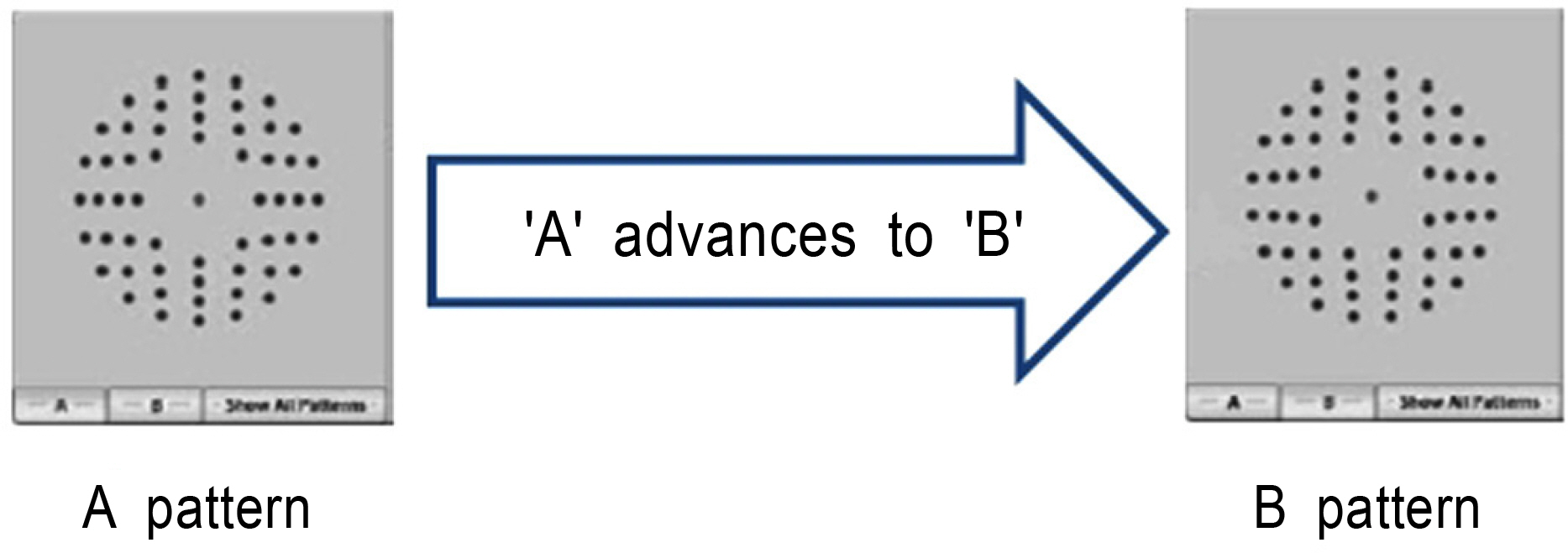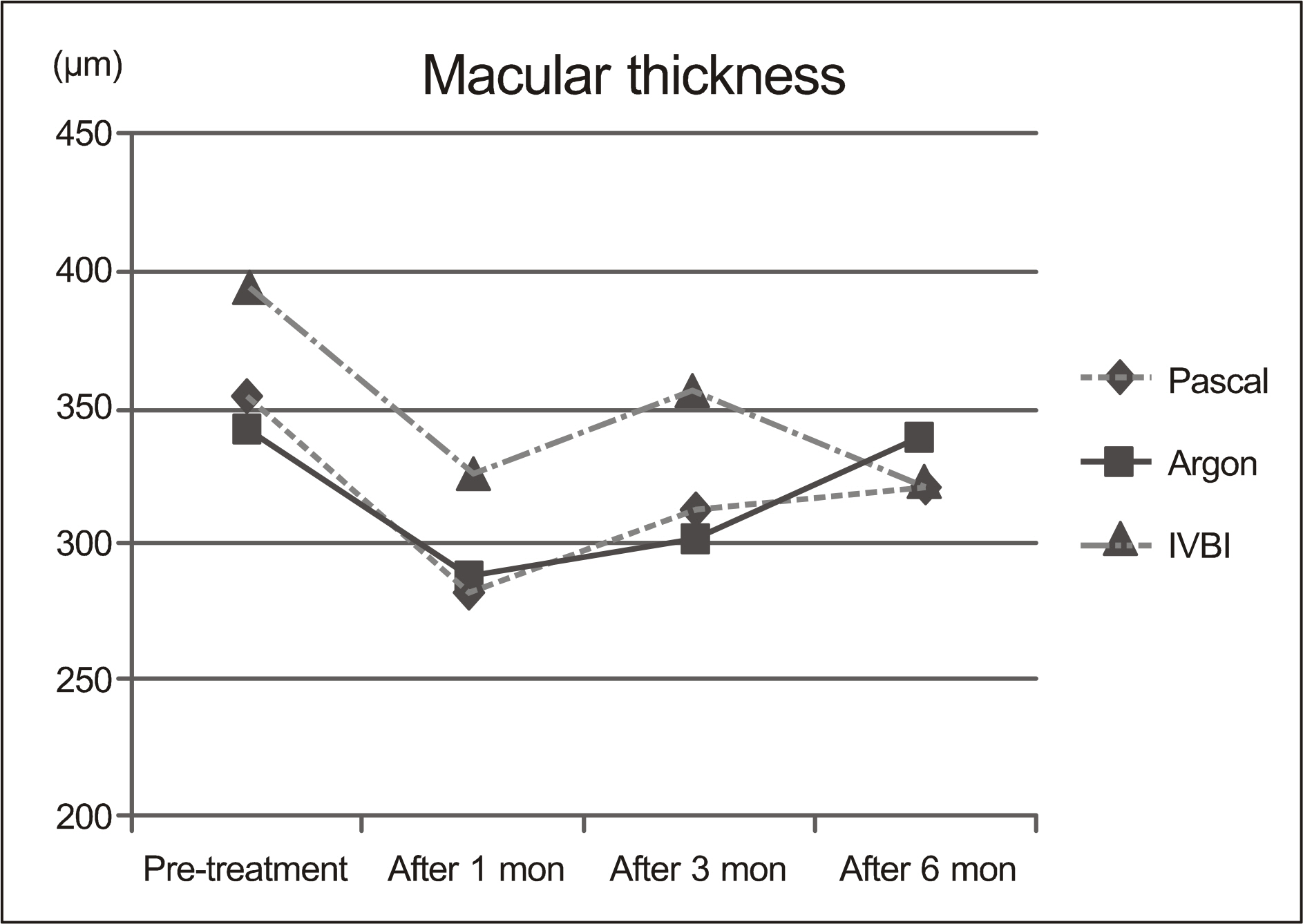J Korean Ophthalmol Soc.
2011 Feb;52(2):197-202.
Effect of Focal and Grid Pattern PASCAL Photocoagulation Treatment in Diabetic Macular Edema
- Affiliations
-
- 1Department of Ophthalmology, Dong-A University College of Medicine, Busan, Korea. wjeye@dau.ac.kr
Abstract
- PURPOSE
To investigate the effect of focal and grid pattern PASCAL photocoagulation treatment in diabetic macular edema patients.
METHODS
A total of 72 patients (75 eyes) who were diagnosed as diabetic macular edema were retrospectively analyzed. The patients were divided into 3 groups as follows: group 1 (31 patients, 31 eyes) received an intravitreal bevacizumab injection, group 2 (17 patients, 20 eyes) underwent focal and grid pattern PASCAL photocoagulation treatment, and group 3 (24 patients, 24 eyes) underwent focal and grid pattern argon photocoagulation treatment. Macular thickness and visual acuity (logMAR) of 75 eyes were compared among groups before and after treatments.
RESULTS
Visual acuity improved in 13 eyes (65.0%) in group 1, 16 eyes (51.6%) in group 2, and in 10 eyes (41.6%) in group 3; however, there was no statistical significance. Macular thickness reduction occurred in 24 eyes (77.4%) in group 1 and 13 eyes (65.0%) in group 2 which were statistically significant decreases at only 1 month after treatment (p < 0.05).
CONCLUSIONS
Focal and grid pattern PASCAL photocoagulation is a good therapeutic option for diabetic macular edema. Focal and grid pattern PASCAL photocoagulation is as effective as intravitreal bevacizumab injection or focal and grid pattern argon photocoagulation treatment.
MeSH Terms
Figure
Reference
-
References
1. Ryan SJ. Nonproliferative diabetic retinopathy. Chew EY, Ferris FL III, editors. Retina. 4th ed.New York: Mosby, Elsevier Inc.;2006. 2:chap. 67.2. Early Treatment Diabetic Retinopathy Study Research Group. Treatment techniques and clinical guidelines for photocoagulation of diabetic macular edema: Early Treatment Diabetic Retinopathy Study report no 2. Ophthalmology. 1987; 94:761–74.3. Early Treatment Diabetic Retinopathy Study Research Group. ETDRS report no. 1: photocoagulation for diabetic macular edema. Arch Ophthalmol. 1985; 103:1796–806.4. Rosenfeld PJ, Moshfeghi AA, Puliafito CA. Optical coherence tomography findings after an intravitreal injection of bevacizumab (Avastin) for neovascular age-related macular degeneration. Ophthalmic Surg Lasers Imaging. 2005; 36:331–5.
Article5. Avery RL, Pieramici DJ, Rabena MD, et al. Intravitreal bevacizumab (Avastin) for neovascular age-related macular degeneration. Ophthalmology. 2006; 113:363–72.
Article6. Avery RL. Regression of retinal and iris neovascularization after intravitreal bevacizumab (Avastin) treatment. Retina. 2006; 26:352–4.
Article7. Spaide RF, Fisher YL. Intravitreal bevacizumab (Avastin) treatment of proliferative diabetic retinopathy complicated by vitreous hemorrhage. Retina. 2006; 26:275–8.
Article8. Blumenkranz MS, Yellachich D, Andersen DE, et al. Semiautomated patterned scanning laser for retinal photocoagulation. Retina. 2006; 26:370–6.
Article9. Sanghvi C, McLauchlan R, Delgado C, et al. Initial experience with the Pascal photocoagulator: a pilot study of 75 procedures. Br J Ophthalmol. 2008; 92:1061–4.
Article10. Cho BJ, Kim TW, Woo SJ, et al. Short-term clinical outcome of patterned scanning laser photocoagulation with short exposure time in diabetic retinopathy. J Korean Ophthalmol Soc. 2009; 50:376–82.
Article11. Kim HK, Han YB. Laser photocoagulation in diabetic macular edema. J Korean Ophthalmol Soc. 1992; 33:759–63.12. Bresnick GH. Diabetic maculopathy; a critical review highlighting diffuse macular edema. Ophthalmology. 1983; 90:1301–17.13. Olk RJ. Modified grid argon (blue-green) laser photocoagulation for diffuse diabetic macular edema. Ophthalmology. 1986; 93:938–50.
Article14. Townsend C, Bailey J, Kohner E. Xenon arc photocoagulation for the treatment of diabetic maculopathy. Interim report of a multi-centre controlled clinical study. Br J Ophthalmol. 1980; 64:385–91.
Article15. Blankenship GW. Diabetic macular edema and argon laser photocoagulation: a prospective randomized study. Ophthalmology. 1979; 86:69–78.
Article16. Bresnick GH. Nonproliferative diabetic retinopathy. Ryan SJ, editor. Retina. 2nd ed.St. Louis: CV Mosby;1994. p. 1277–318.17. Shahidi M, Ogura Y, Blair NP, Zeimer R. Retinal thickness change after focal laser treatment of diabetic macular edema. Br J Ophthalmol. 1994; 78:827–30.18. Hurwitz H, Fehrenbacher L, Novotny W, et al. Bevacizumab plus irinotecan, fluorouracil, and leucovorin for metastatic colorectal cancer. N Engl J Med. 2004; 350:2335–42.
Article19. Brooks HL, Caballero S, Newell CK, et al. Vitreous levels of vascular endothelial growth factor and stromal-derived factor 1 in patients with diabetic retinopathy and cystoid macular edema before and after intraocular injection of triamcinolone. Arch Ophthalmol. 2004; 122:1801–7.
- Full Text Links
- Actions
-
Cited
- CITED
-
- Close
- Share
- Similar articles
-
- Laser Photocoagulation in Diabetic Macular Edema
- Laser Photocoagulation in Diabetic Macular Edema
- Grid-Pattern Laser Photocoagulation in Diabetic Macular Edema
- Visual Results after Grid Laser Photocoagulation for Diffuse Diabetic Macular Edema
- Laser Photocoagulation Combined with Intravitreal Triamcinolone Acetonide Injection in Proliferative Diabetic Retinopathy with Macular Edema




